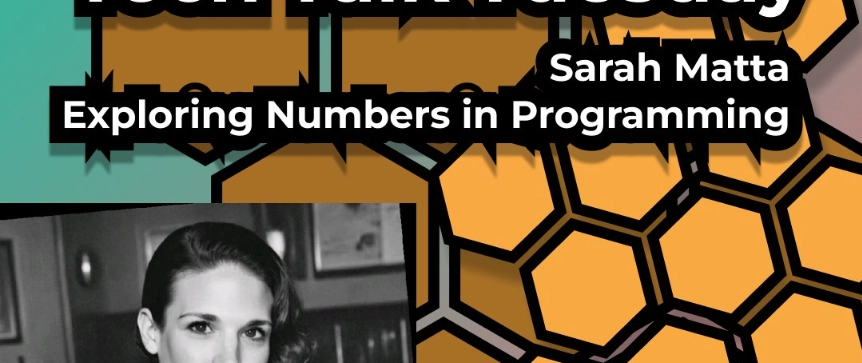Hi! I’m Sarah.
I am a self-taught programmer with a passion for where math meets programming.
This blog post represents a talk I gave at the inaugural Tech Talk Augusta.
As an introduction to my talks, I like to read the intro to Neil deGrasse Tyson’s Starry Messenger because it is applicable as well as impactful to STEM and it really sets the mood to consume and digest STEM considerations that you're about to hear (or read, in this instance). You can read it here: Starry Messenger
What is STEM? (o゜▽゜)o☆
Science, Technology, Engineering, and Mathematics. STEM builds the communities and realities that we live in. It both reflects on the past and propels us forward.
Today, let's focus on the M in STEM - Mathematics!
You Know More Math Than You Think ╰(°▽°)╯
I have always loved math, but I never progressed as far as I would have liked (and still would like to). I’ve heard many programmers say similar things. People often claim they “don’t know math.”
If you just thought to yourself:
(>﹏<)
“Yep, that’s me”
today I’m going to try to convince you that you know more than you realize.
Number Sense ♪(^∇^*)
What is Number Sense? ヾ(@⌒ー⌒@)ノ
I believe I have “strong number sense.” Number sense is the intuitive understanding of numbers and their relationships. It starts with grasping concepts like:
Quantities
More & less
Bigger & smaller
To understand these concepts is to understand math logic. Understanding math logic is comparable to understanding programming logic.
Math is Logic (~ ̄▽ ̄)~
How many of you know what this symbol is?
How many of you understand it?
This is Sigma notation, also known as summation. It represents:
Performing an operation (right)
Starting from a defined lower bound (bottom)
Going up to a defined upper bound (top)
Incrementing at each step
Adding each result to an overall sum
How many of you know what this is?
for (let i = start; i <= end; i++) {
sum += operation(i);
}
Yes! It’s a for loop.
Guess what? They’re the same! Sigma is a For Loop!
for (let i = 1; i <= 4; ++i){
sum += i*i;
}
Now, how many of you understand Sigma notation?
The Power of Number Sense in Programming (⓿_⓿)
Problem-Solving Foundation ( *︾▽︾)
Good number sense is foundational to problem-solving. And how many of us would call programming problem-solving? 🙋♂️
Math teaches logical reasoning and problem-solving skills that are essential in programming. It helps in breaking down complex problems into smaller, manageable parts just like writing a program or debugging code.
A friend once said:
“My high school geometry class is what helped me start to excel at programming. My teacher emphasized proof-based geometry, and it really helped me figure out how to break big problems down into smaller ones.”
Math is Logic, Programming is Logic (〃 ̄︶ ̄)人( ̄︶ ̄〃)
This talk is focused on numbers specifically, so let’s adventure beyond bits and bytes and explore The Numeric Foundation of Programming.
Precision vs. Accuracy: A Computational Perspective
If precision vs accuracy sounds familiar to you, you have probably taken a physics class! 😆
In programming, they have distinct meanings and can have profound implications.
Precision refers to the level of detail in a measurement or calculation. Example: the number of decimal places a computation can represent.
Accuracy refers to how close a result is to the actual, true value. It’s about correctness, not just detail.
| Concept | Definition | Example |
|---|---|---|
| Precision | Level of detail in a result | 3.1415926535 (high precision, may not be accurate) |
| Accuracy | Closeness to the true value | 3.14 (lower precision, but accurate) |
Speed vs. Correctness
Speed depends on numeric type and computation method.
Context determines the right approach.
So what does precision vs. accuracy mean in programming?
Binary vs. Decimal: The Foundations of Numeric Representation ◑﹏◐
Decimal vs. Binary in Csharp
// Decimal vs Binary floating-point comparison
double binaryResult = 0.1 + 0.2; // 0.30000000000000004 - fast
decimal decimalResult = 0.1m + 0.2m; // Exactly 0.3 - slow
double binaryResult = 0.1 + 0.2;represents precision because it provides many decimal places but isn't exactly accurate. It’s faster but has a small error.decimal decimalResult = 0.1m + 0.2m;represents accuracy because it gives exactly0.3. It’s slower, but mathematically correct.
Binary Numerical Systems (Base-2)
Binary numbers are the native language of computers, representing data using only two states: 0 and 1. This fundamental representation stems from electronic circuitry's on/off nature.
Decimal Numerical Systems (Base-10)
Decimal numbers represent our natural human counting system, using ten distinct digits (0-9).
Performance Considerations
- Binary is the most efficient for computer processing.
- Decimal calculations are precise but the slowest for computer processing.
- Decimal also requires conversion for computer storage.
Common Use Cases:
| Type | Used For |
|---|---|
| Binary | Performance-critical computations, game development, memory-constrained environments |
| Decimal | Financial calculations, scientific measurements |
Conclusion []~( ̄▽ ̄)~*
Math is deeply embedded in programming. Understanding number sense, precision vs. accuracy, and binary vs. decimal can help programmers write more efficient and effective code.
So the next time you think, “I don’t know math”, remember - you already use it every day in programming!





Top comments (2)
Maths are also used by programmers to build AI....This is so practical 🤗
Absolutely! I'm currently reading a preview of a book called Rebels of Reason by John Willis & Derek Lewis. I attended a RAG workshop from John Willis at All Things Open AI conference, he gave out signed copied during the conference.
In it, he says "if you can grasp predictive text, you're halfway to understanding AI. It's not magic. It's math."
You can read about it here linkedin.com/pulse/first-look-rebe...